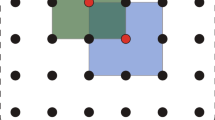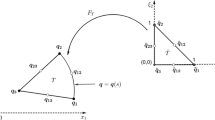Abstract
This study introduces an innovative dynamic infinite meshfree method for robust and efficient solutions to half-space problems. This approach seamlessly couples this method with the nodal integral reproducing kernel particle method to discretize half-spaces defined by an artificial boundary. The infinite meshfree shape function is uniquely constructed using the 1D reproducing kernel shape function combined with the boundary singular kernel method, ensuring the Kronecker delta property on artificial boundaries. Coupled with the wave-transfer function, the proposed approach models dissipation actions effectively. The infinite domain simulation employs the dummy node method, enhanced by Newton–Cotes integrals. To ensure solution stability and convergence, our approach is based on the Galerkin weak form of the domain integral method. To combat the challenges of instability and imprecision, we integrated the stabilized conforming nodal integration method and the naturally stable nodal integration. The proposed methods efficacy is validated through various benchmark problems, with preliminary results showcasing superior precision and stability.





















Similar content being viewed by others
Data availability
The data that support the findings of this study are available from the corresponding author upon reasonable request.
References
Beissel S, Belytschko T (1996) Nodal integration of the element-free Galerkin method. Comput Methods Appl Mech Eng 139(1–4):49–74
Belytschko T, Lu YY, Gu L (1994) Element-free Galerkin methods. Int J Numer Methods Eng 37(2):229–256
Belytschko T, Lu YY, Gu L (1995) Crack propagation by element-free Galerkin methods. Eng Fract Mech 51(2):295–315
Belytschko T, Guo Y, Kam Liu W et al (2000) A unified stability analysis of meshless particle methods. Int J Numer Methods Eng 48(9):1359–1400
Berenger JP (1994) A perfectly matched layer for the absorption of electromagnetic waves. J Comput Phys 114(2):185–200
Bettess P, Zienkiewicz O (1977) Diffraction and refraction of surface waves using finite and infinite elements. Int J Numer Methods Eng 11(8):1271–1290
Chen JS, Wang HP (2000) New boundary condition treatments in meshfree computation of contact problems. Comput Methods Appl Mech Eng 187(3–4):441–468
Chen JS, Pan C, Wu CT et al (1996) Reproducing kernel particle methods for large deformation analysis of non-linear structures. Comput Methods Appl Mech Eng 139(1–4):195–227
Chen JS, Wu CT, Yoon S et al (2001) A stabilized conforming nodal integration for Galerkin mesh-free methods. Int J Numer Methods Eng 50(2):435–466
Chen JS, Yoon S, Wu CT (2002) Non-linear version of stabilized conforming nodal integration for Galerkin mesh-free methods. Int J Numer Methods Eng 53(12):2587–2615
Chen JS, Han W, You Y et al (2003) A reproducing kernel method with nodal interpolation property. Int J Numer Methods Eng 56(7):935–960
Chen JS, Zhang X, Belytschko T (2004) An implicit gradient model by a reproducing kernel strain regularization in strain localization problems. Comput Methods Appl Mech Eng 193(27–29):2827–2844
Chen JS, Hillman M, Rüter M (2013) An arbitrary order variationally consistent integration for Galerkin meshfree methods. Int J Numer Methods Eng 95(5):387–418
Chen JS, Hillman M, Chi SW (2017) Meshfree methods: progress made after 20 years. J Eng Mech 143(4):4017001
Curnier A (1983) A static infinite element. Int J Numer Methods Eng 19(10):1479–1488
Du H, Wu J, Wang D, et al (2022) A unified reproducing kernel gradient smoothing galerkin meshfree approach to strain gradient elasticity. Comput Mech 70(1):73–100
Engquist B, Majda A (1977) Absorbing boundary conditions for numerical simulation of waves. Proc Natl Acad Sci 74(5):1765–1766
Fernández-Méndez S, Huerta A (2004) Imposing essential boundary conditions in mesh-free methods. Comput Methods Appl Mech Eng 193(12):1257–1275
Guan PC, Chen JS, Wu Y et al (2009) Semi-Lagrangian reproducing kernel formulation and application to modeling earth moving operations. Mech Mater 41(6):670–683
Guan PC, Chi SW, Chen JS et al (2011) Semi-Lagrangian reproducing kernel particle method for fragment-impact problems. Int J Impact Eng 38(12):1033–1047
He Y, Yang H, Deeks AJ (2013) An element-free Galerkin scaled boundary method for steady-state heat transfer problems. Numer Heat Transf 64(3):199–217
Hillman M, Chen JS (2016) An accelerated, convergent, and stable nodal integration in Galerkin meshfree methods for linear and nonlinear mechanics. Int J Numer Methods Eng 107(7):603–630
Hillman M, Lin KC (2021) Consistent weak forms for meshfree methods: full realization of h-refinement, p-refinement, and a-refinement in strong-type essential boundary condition enforcement. Comput Methods Appl Mech Eng 373:113448
Huang TH, Wei H, Chen JS et al (2020) Rkpm2d: an open-source implementation of nodally integrated reproducing kernel particle method for solving partial differential equations. Comput Part Mech 7:393–433
Lin KC, Hsieh HL, Yang YB et al (2023) A coupled rkpm and dynamic infinite element approach for solving static and transient heat conduction problems. Eng Anal Bound Elem 150:528–541
Lin SP, Chen JS, Liang S (2016) A damage analysis for brittle materials using stochastic micro-structural information. Comput Mech 57:371–385
Liu G, Zhang G, Wang Y et al (2007) A nodal integration technique for meshfree radial point interpolation method (ni-rpim). Int J Solids Struct 44(11–12):3840–3860
Liu WK, Chen Y (1995) Wavelet and multiple scale reproducing kernel methods. Int J Numer Methods Fluids 21(10):901–931
Liu WK, Jun S, Zhang YF (1995) Reproducing kernel particle methods. Int J Numer Methods Fluids 20(8–9):1081–1106
Lu Y, Belytschko T, Gu L (1994) A new implementation of the element free Galerkin method. Comput Methods Appl Mech Eng 113(3–4):397–414
Mahdavi A, Chi SW, Zhu H (2019) A gradient reproducing kernel collocation method for high order differential equations. Comput Mech 64:1421–1454
Nayroles B, Touzot G, Villon P (1992) Generalizing the finite element method: diffuse approximation and diffuse elements. Comput Mech 10(5):307–318
Nitsche J (1971) Über ein Variationsprinzip zur Lösung von Dirichlet-Problemen bei Verwendung von Teilräumen, die keinen Randbedingungen unterworfen sind. Abhandlungen aus dem mathematischen Seminar der Universität Hamburg 36(1):9–15
Nowacki W (1975) Dynamic problems of thermoelasticity. Springer Science & Business Media, Berlin
Sacks ZS, Kingsland DM, Lee R et al (1995) A perfectly matched anisotropic absorber for use as an absorbing boundary condition. IEEE Trans 43(12):1460–1463
Ungless RF (1973) Infinite finite element. Ph.D. thesis, University of British Columbia
Wang D, Wu J (2016) An efficient nesting sub-domain gradient smoothing integration algorithm with quadratic exactness for Galerkin meshfree methods. Comput Methods Appl Mech Eng 298:485–519
Wang D, Wu J (2019) An inherently consistent reproducing kernel gradient smoothing framework toward efficient Galerkin meshfree formulation with explicit quadrature. Comput Methods Appl Mech Eng 349:628–672
Wolf JP, Song C (1996) Finite-element modelling of unbounded media. Wiley, Chichester
Wu J, Wang D (2021) An accuracy analysis of Galerkin meshfree methods accounting for numerical integration. Comput Methods Appl Mech Eng 375:113631
Wu J, Wu X, Zhao Y et al (2023) A rotation-free Hellinger–Reissner meshfree thin plate formulation naturally accommodating essential boundary conditions. Eng Anal Bound Elem 154:122–140
Yang JP, Chen JY (2017) Strong-form formulated generalized displacement control method for large deformation analysis. Int J Appl Mech 9(07):1750101
Yang JP, Su WT (2016) Strong-form framework for solving boundary value problems with geometric nonlinearity. Appl Math Mech 37(12):1707–1720
Yang YB, Hung HH (2001) A 2.5 d finite/infinite element approach for modelling visco-elastic bodies subjected to moving loads. Int J Numer Methods Eng 51(11):1317–1336
Yang YB, Kuo SR, Hung HH (1996) Frequency-independent infinite elements for analysing semi-infinite problems. Int J Numer Methods Eng 39(20):3553–3569
Yang YB, Hung HH, Chang DW (2003) Train-induced wave propagation in layered soils using finite/infinite element simulation. Soil Dyn Earthq Eng 23(4):263–278
Yang YB, Hung HH, Lin KC et al (2015) Dynamic response of elastic half-space with cavity subjected to p and sv waves by finite/infinite element approach. Int J Struct Stab Dyn 15(07):1540009
Yu N, Imatani S, Inoue T (2004) Characteristics of temperature field due to pulsed heat input calculated by non-fourier heat conduction hypothesis. JSME Int J A Solid M 47(4):574–580
Zhu T, Atluri S (1998) A modified collocation method and a penalty formulation for enforcing the essential boundary conditions in the element free galerkin method. Comput Mech 21(3):211–222
Zienkiewicz O, Bettess P (1976) Infinite elements in the study of fluid-structure interaction ppoelems. Springer, Berlin, pp 133–172
Acknowledgements
This study was supported by the National Science and Technology Council (NSTC), Taiwan, under project contract numbers MOST 111-2221-E-006-036 and NSTC 112-2625-M-006-006. Assistance with the illustrations by Kuan-Ting Lin is also acknowledged and appreciated.
Author information
Authors and Affiliations
Corresponding author
Ethics declarations
Conflict of interest
The authors declare no conflict of interest.
Additional information
Publisher's Note
Springer Nature remains neutral with regard to jurisdictional claims in published maps and institutional affiliations.
Rights and permissions
Springer Nature or its licensor (e.g. a society or other partner) holds exclusive rights to this article under a publishing agreement with the author(s) or other rightsholder(s); author self-archiving of the accepted manuscript version of this article is solely governed by the terms of such publishing agreement and applicable law.
About this article
Cite this article
Lin, KC., Chen, TW. & Hsieh, HL. A stable and efficient infinite meshfree approach for solving half-space eat conduction problems. Engineering with Computers (2024). https://doi.org/10.1007/s00366-024-01960-w
Received:
Accepted:
Published:
DOI: https://doi.org/10.1007/s00366-024-01960-w




